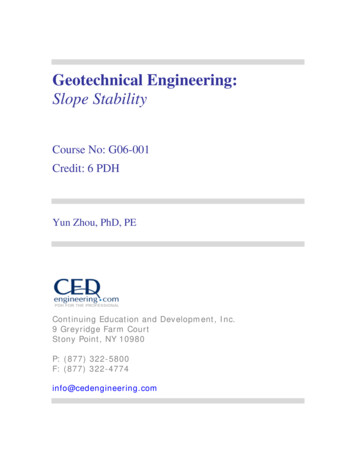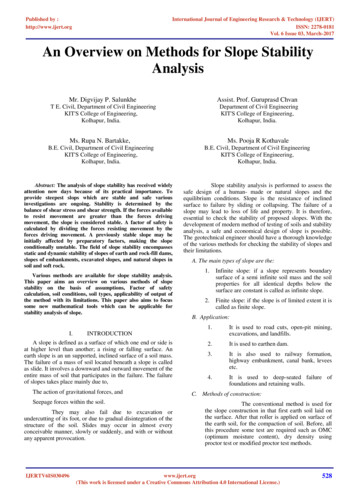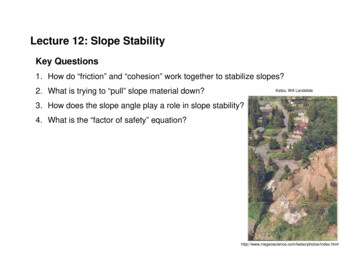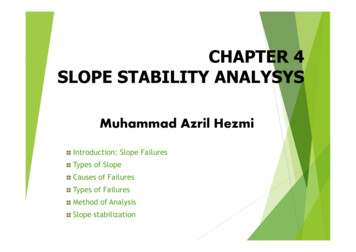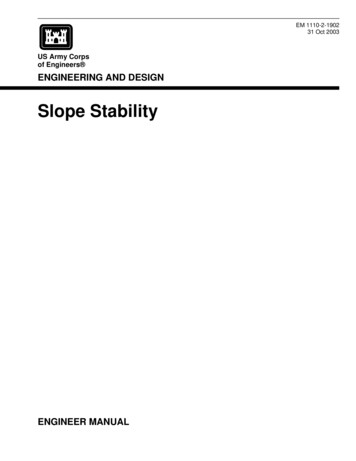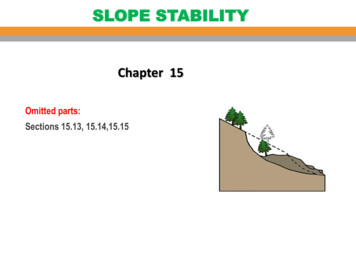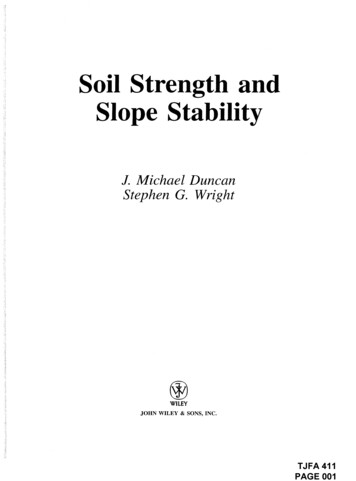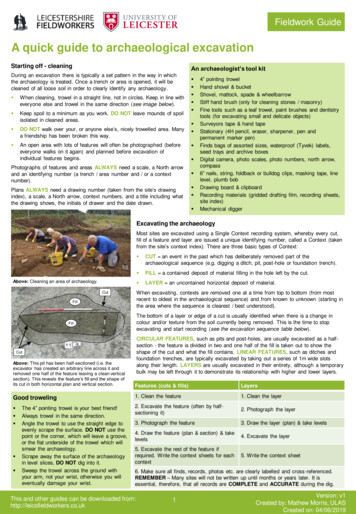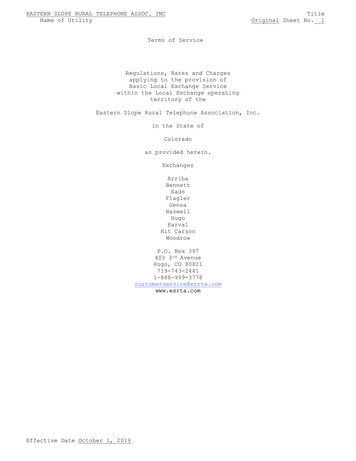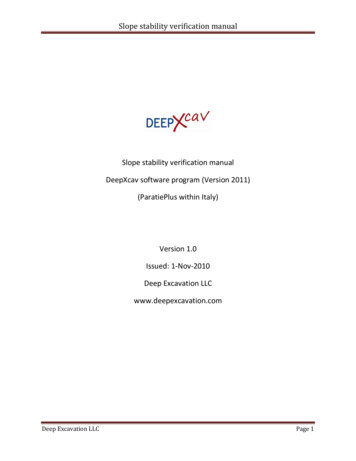
Transcription
Slope stability verification manualSlope stability verification manualDeepXcav software program (Version 2011)(ParatiePlus within Italy)Version 1.0Issued: 1‐Nov‐2010Deep Excavation LLCwww.deepexcavation.comDeep Excavation LLCPage 1
Slope stability verification manualTABLE OF CONTENTSA. INTRODUCTIONB. Slope stability verification problem #1Simple SlopeC. Slope stability verification problem #2Tension crackD. Slope stability verification problem #3Non‐homogeneousE. Slope stability verification problem #4Non‐homogeneous with seismic loadF. Slope stability verification problem #5Water table modeled with weak seamG. Slope stability verification problem #6Previous problem with predefined slip surfaceH. Slope stability verification problem #7External loading, pore pressure defined by water tableI. S Slope stability verification problem #8Pore pressure defined by digitized total head gridJ. Slope stability verification problem #9Pore pressure defined by pore pressure gridk. Slope stability verification problem #10Verification example with soil nails from FHWA soil nailing manualDeep Excavation LLCPage 2
Slope stability verification manualA. INTRODUCTIONThis document contains a series of verification slope stability problems that have been analyzedusing DeepXCav 2010. These verification tests come from: A set of 5 basic slope stability problems, together with 5 variants, was distributed in theAustralian Geomechanics profession and overseas as part of a survey sponsored by ACADS(Association for Computer Aided Design), in 1988. The DeepXCav verification problems #1 to#10 are based on these ACADS example problems (Giam & Donald (1989)). Published examples found in reference material such as journal and conference proceedings.For all examples, a short statement of the problem is given first, followed by a presentation of theanalysis results, using various limit equilibrium analysis methods.All examples are analysed not only in the original, but also in the reversed form, so that the DeepXCavcan be better veriffied.Deep Excavation LLCPage 3
Slope stability verification manualB. Slope verification problem#1Simple SlopeB.1 Problem DescriptionThe first problem is the simple case of a total stress analysis withoutconsidering pore water pressures. The soil properties are presented in Table 1 and the model of theproblem is shown in Figure 1. The factor of safety and its corresponding critical circular failure isrequired.Table B.1: Material Propertiesc (kN/m2)3.0φ (deg.)19.6γ (kN/m3)20.0Figure B.1‐ Model of the problemDeep Excavation LLCPage 4
Slope stability verification manualB.2 ResultsMethod: BishopNormal modelReversed modelFactor of Safety0.9780.994Note : Referee Factor of Safety 1.00 [Giam]Mean Bishop FOS (18 samples) 0.993Mean FOS (33 samples) 0.991Figure B.2 – Normal model solutionFigure B.3 – Reversed model solutionDeep Excavation LLCPage 5
Slope stability verification manualC. Slope verification problem#2Tension crackC.1 Problem DescriptionThis problem has the exact slope geometry as the Verification problem #2, with the addition of atension crack zone. A suitable tension crack depth D is required and it can be estimated from thefollowing equations [Craig (1997)]:D 2*c/(γ Κα) , Κα (1 ‐ sinφ)/( 1 sinφ)Table C.1: Material Propertiesc (kN/m2)3.0φ (deg.)10.0γ (kN/m3)20.0Figure C.1‐ Model of the problemDeep Excavation LLCPage 6
Slope stability verification manualC.2 ResultsMethod: BishopNormal modelReversed modelFactor of Safety1.6181.614Method: MPNormal modelReversed modelFactor of Safety1.5551.536Note : Referee Factor of Safety 1.65 [Giam]Figure C.2 – BISHOP ‐ Normal model solutionFigure C.3 – BISHOP ‐ Reversed model solutionDeep Excavation LLCPage 7
Slope stability verification manualFigure C.4 – MP ‐ Normal model solutionFigure C.5 – MP – Reversed model solutionDeep Excavation LLCPage 8
Slope stability verification manualD. Slope verification problem#3Non‐homogeneousD.1 Problem DescriptionThis problem is a non‐homogeneous, three layer slope. The factor of safety and its corresponding criticalcircular failure surface is required.Table D.1: Material PropertiesSoil 1Soil 2Soil 3c (kN/m2)0.05.37.2φ (deg.)38.023.020.0γ (kN/m3)19.519.519.5Figure D.1‐ Model of the problemDeep Excavation LLCPage 9
Slope stability verification manualD.2 ResultsMethod: GLENormal modelReversed modelFactor of Safety1.3781.384Note : Referee Factor of Safety 1.39 [Giam]Mean Bishop FOS (16 samples) 1.406Mean FOS (31 samples) 1.381Figure D.2 – GLE ‐ Normal model solutionFigure D.3 – GLE – Reversed model solutionDeep Excavation LLCPage 10
Slope stability verification manualE. Slope verification problem#4Non‐homogeneous with seismic loadE.1 Problem DescriptionVerification problem #4 is identical to problem #3, but with a horizontal seismically induced accelerationof 0.15g included in the analysis. The factor of safety and its corresponding critical circular failuresurface is required.Table E.1: Material PropertiesSoil 1Soil 2Soil 3c (kN/m2)0.05.37.2φ (deg.)38.023.020.0γ (kN/m3)19.519.519.5Figure E.1‐ Model of the problemDeep Excavation LLCPage 11
Slope stability verification manualE.2 ResultsMethod: GLENormal modelReversed modelFactor of Safety0.9850.993Method: BISHOPNormal modelReversed modelFactor of Safety0.9841.015Note : Referee Factor of Safety 1.00 [Giam]Mean Bishop FOS (15 samples) 0.973Figure E.2 – GLE ‐ Normal model solutionFigure E.3 – GLE – Reversed model solutionDeep Excavation LLCPage 12
Slope stability verification manualFigure E.4– BISHOP ‐ Normal model solutionFigure E.5– BISHOP – Reversed model solutionDeep Excavation LLCPage 13
Slope stability verification manualF. Slope verification problem#5Water table modeled with weak seamF.1 Problem DescriptionIn this problem, the water table is assumed to coincide with the base of the weak layer. The effect ofnegative pore water pressure above the water table and the effect of the tension crack is to be ignored.The factor of safety and its corresponding critical non‐circular failure surface is required.Table F.1: Material PropertiesSoil 1Soil 2c (kN/m2)28.50.0φ (deg.)20.010.0γ (kN/m3)18.8418.84Figure F.1‐ Model of the problemDeep Excavation LLCPage 14
Slope stability verification manualF.2 ResultsMethod: SPENCERNormal modelReversed modelFactor of Safety1.1981.195Note : Referee Factor of Safety 1.24 – 1.27 [Giam]Mean Non‐circular FOS (19 samples) 1.293Figure F.2– SPENCER ‐ Normal model solutionFigure F.3– SPENCER ‐ Reversed model solutionDeep Excavation LLCPage 15
Slope stability verification manualG. Slope verification problem#6Previous problem with predefined slip surfaceG.1 Problem DescriptionThis problem is identical to verification problem #5. The only difference is that a non‐circular slip surfaceof known coordinates is analysed.Table G.1: Material PropertiesSoil 1Soil 2c (kN/m2)28.50.0φ (deg.)20.010.0γ (kN/m3)18.8418.84Figure G.1‐ Model of the problemTable G.2: Failure Surface CoordinatesX (m)Y (m)41.8527.7544.0026.5063.5027.0073.3140.00Axis of Rotation: (53.3, 45)Deep Excavation LLCPage 16
Slope stability verification manualG.2 ResultsMethod: SPENCERNormal modelReversed modelFactor of Safety1.3141.313Note : Referee Factor of Safety 1.34 [Giam]Mean FOS (30 samples) 1.29Figure G.2– SPENCER ‐ Normal model solutionFigure G.3– SPENCER ‐ Reversed model solutionDeep Excavation LLCPage 17
Slope stability verification manualH. Slope verification problem#7External loading, pore pressure defined by water tableH.1 Problem DescriptionThe soil parameters of this problem, the external loadings and the piezometric surface are shown inTables G.1, G.2 and G.3 respectively. The effect of the tension crack is to be ignored. The factor of safetyand its corresponding critical non‐circular failure surface is required.Table H.1: Material PropertiesSoil 1Soil 2c (kN/m2)28.50.0φ (deg.)20.010.0γ (kN/m3)18.8418.84Table H.2: external LoadingsX (m)23.0043.0070.0080.00Y (m)27.7527.7540.0040.00Normal Stress (kN/m2)20.0020.0020.0040.00Table H.3: Data for Piezometric surfaceXc (m)20.0043.0049.0060.0066.0074.0080.0084.00Deep Excavation LLCYc (m)27.7527.7529.834.0035.8037.6038.4038.40Page 18
Slope stability verification manualFigure H.1‐ Model of the problemH.2 ResultsMethod: SPENCERNormal modelReversed modelFactor of Safety0.6930.693Note: Referee Factor of Safety 0.78 [Giam]Mean Non‐circular FOS (20 samples) 0.808Referee GLE Factor of Safety 0.6878 [Slope 2000]Deep Excavation LLCPage 19
Slope stability verification manualFigure H.2– SPENCER ‐ Normal model solutionFigure H.3– SPENCER ‐ Reversed model solutionDeep Excavation LLCPage 20
Slope stability verification manualI. Slope verification problem#8Pore pressure defined by digitized total head gridI.1 Problem DescriptionThis slope has been excavated at a slope of 1:2 (β 26.56 ) below an initially horizontal groundsurface.The position of the critical slip surface and the corresponding factor of safety are required forthe long term condition, i.e. after the ground water conditions have stabilized. Grid interpolation is donewith TIN triangulation. The critical slip surface (circular) and the corresponding factor of safety arerequired.Table I.1: Material Propertiesc (kN/m2)11.0φ (deg.)28.0γ (kN/m3)20.00Figure I.1‐ Model of the problemDeep Excavation LLCPage 21
Slope stability verification manualI.2 ResultsMethod: SPENCERNormal modelReversed modelFactor ofSafety1.4681.462Method: GLENormal modelReversed modelFactor ofSafety1.4411.439Method: BISHOPNormal modelReversed modelFactor ofSafety1.4951.417Note: Referee Factor of Safety 1.53 [Giam]Mean FOS (23 samples) 1.464Figure I.2– SPENCER ‐ Normal model solutionFigure I.3– SPENCER ‐ Reversed model solutionDeep Excavation LLCPage 22
Slope stability verification manualFigure I.4– GLE ‐ Normal model solutionFigure I.5– GLE ‐ Reversed model solutionDeep Excavation LLCPage 23
Slope stability verification manualFigure I.6– BISHOP ‐ Normal model solutionFigure I.7– BISHOP ‐ Reversed model solutionDeep Excavation LLCPage 24
Slope stability verification manualJ. Slope verification problem#9Pore pressure defined by pore pressure gridJ.1 Problem DescriptionThe material properties of this problem are given in Table J.1. The position of the critical slip surface andthe corresponding factor of safety are required. Pore water pressures were derived from the given equalpore pressure lines on Figure 11. using the Thin‐Plate Spline interpolation method.Table J.1: Material PropertiesEmbankmentClay foundationc (kN/m2)0.02.0φ (deg.)44.028.0γ (kN/m3)18.816.68Figure J.1‐ Model of the problemDeep Excavation LLCPage 25
Slope stability verification manualJ.2 ResultsMethod: SPENCERNormal modelReversed modelFactor of Safety0.907‐Note: Referee Factor of Safety 1.04 [Pilot]Figure J.2– SPENCER ‐ Normal model solutionDeep Excavation LLCPage 26
Slope stability verification manualk. Slope verification problem #10Verification example with soil nails from FHWA soil nailing manualk.1 Problem DescriptionThe material properties of this problem are given in Table k.1. The position of the critical slip surface andthe corresponding factor of safety are required. A safety factor of 2 is used in the soil nail skinresistance.Table k.1: Material PropertiesSandc (ksf)φ (deg.)γ (pcf)0.132120qSkin Ult(psi)50All soil nails have Fy 60 ksi and an area of 1in2. The horizontal spacing is assumed at 5 ft.Figure k.1‐ Model of the problemDeep Excavation LLCPage 27
Slope stability verification manualk.2 ResultsMethod: MPNormal modelReversed modelFactor of Safety1.92‐Figure k.2– Results with DeepXcavDeep Excavation LLCPage 28
This document contains a series of verification slope stability problems that have been analyzed using DeepXCav 2010. These verification tests come from: A set of 5 basic slope stability problems, together with 5 variants, was distributed in the
